Camping in a VW classic van
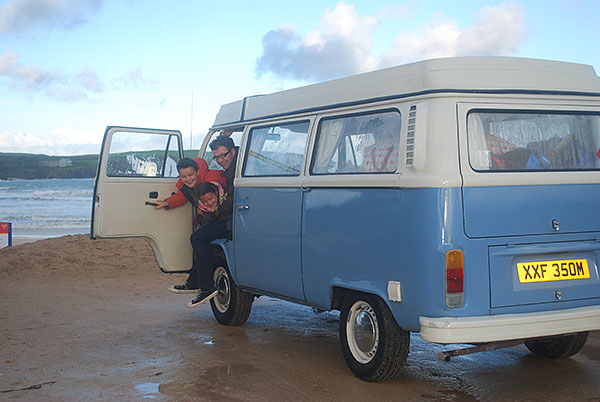
Simply sign up to the Life & Arts myFT Digest -- delivered directly to your inbox.
Is November just about the worst time of year to make your first trip in a vintage VW camper? All week people have been making reassuring noises (“You will literally freeze/die,” my wife’s friend tells us). But I know we’re in trouble when the company that hires out the vans asks whether we’re sure we want to go through with it. The forecast is terrible, says Penny Scott, who owns O’Connors Campers in Okehampton, Devon.
Yet cold and rain aside, it seems a fitting moment to get to grips with the famous friendly-faced bus that started life as a goods van in postwar Germany, became a symbol of 1960s peace and love, and remains a must-have for serious surfers today. Next month, 64 years after it was unveiled at the 1949 Geneva Motor Show, the original VW Type 2 (also known as the Transporter, Kombi, Microbus or just camper) will retire. Changes to health and safety rules in Brazil – where the bus is still manufactured three decades after it stopped being made in Germany – have made further production impossible.
A significant chapter in motoring history is coming to a close. But there is still time to live the “V Dub dream”. The cult of the camper goes on in a booming “scene” of shows and events and, for the less committed, through hire companies such as O’Connors, whose colourful collection of retro buses appeals to those who like a bit of Cath Kidston with their counterculture. For a family man with a wife, two young children and no discernible camping expertise, this seems an appealing way to take to the open road. But is it really possible just to turn up, tune in and drop out in a camper for the weekend?
When we get to O’Connors, Penny says they are often amazed at how people arrive, “sometimes still wearing suits”, looking strung out. Yet after a few days driving around in Battenberg or Noddy Windsor (VW campers are pretty much required to have quirky names), these same uptight individuals return virtually unrecognisable – some are even wearing shorts.
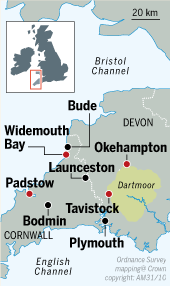
We’ve chosen Wolverine, a 1974 four-berth powder-blue and white van with “bay” windscreen (until 1967 VW campers had split-screens) previously abandoned in a garage. Today it is immaculate, right down to checkerboard flooring and blue spotted curtains. Another bus, Uma, was being used as a log store when it was rescued and restored.
Romantic stories are a big part of the camper’s appeal. This year O’Connors has had 17 bookings for a combination of weddings and honeymoons, including the man who tracked down his father’s old “splitty” for his own daughter’s big day. When the unsuspecting grandad was reunited with his bus, he didn’t say a lot “but he spent a lot of time just sitting in it”.
The romance of driving Wolverine eludes me at first. It takes a quarter of an hour to find reverse gear and leave the car park in Okehampton and even longer to reach the main road – I miss the turnings and can’t face trying to reverse. But eventually we hit the A30 and pretty soon I am reaching speeds in excess of 39mph, swooping up and down the hills that lead from Devon into Cornwall. Padstow, about 60 miles west, is reached in a mere two hours, as darkness descends.
The genius of driving a tent on wheels is that there is no pitching to do. Plus at most campsites you can hook up to the mains and plug in a heater. Camping in November is not so much about letting the outside in as shutting it out, but hot chocolate and board games remain constants.
So, I ask the children, what do you think of living in a van then? My son says he’s surprised by how well it works, even though it’s 40 years old. My daughter, clambering round the top bunk in the pop-up roof, pauses to consider the majesty of sleeping under the stars, then says: “Feels a bit weird not having a telly.” As we join the Friday night throng at the Cornish Arms, I feel like we’re not quite living the dream yet – but at least I know how to reverse out of the car park.
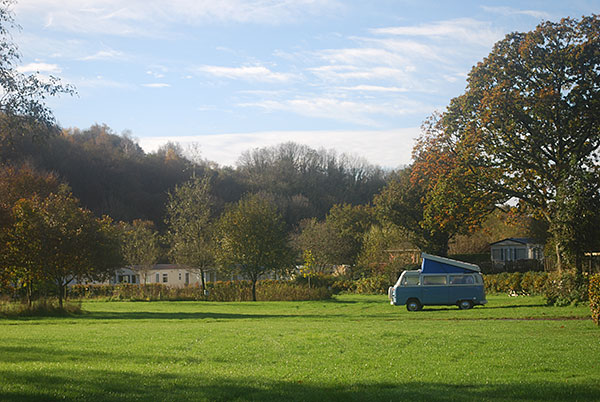
So where does the affection and fascination that continues to surround this vehicle come from? Partly it’s the look. “They’re a design classic,” says James Peene, group editor of VolksWorld and Camper & Bus magazines. “And they were really user-friendly.” But there’s also the thrill of driving what is, increasingly, a vintage motor. “You get into a different mindset,” says Peene. “Driving becomes more about the journey than the destination. Other VW owners wave or flash their lights as you drive towards each other. They usually stop when you’ve broken down on the side of the road or just come over to talk to you. You just don’t get that with any other make or type of car.”
The camper’s cultural heritage also plays a part. By the 1950s people across the western world were holidaying in camper vans of various types. On the US west coast, surfers discovered that VW’s campers were the ideal way to live by the beach. But by the 1960s and 1970s these disarming-looking buses began to go further afield than the seaside or the national park. Painted in flowers and peace symbols, campers blazed the hippy trail to far-off and far-out places such as Kathmandu. In the process they, too, became symbols – of peace, freedom and of a lifestyle that challenged the conventional suburban dream.
Is this really still a part of why people yearn to drive a VW bus? According to Peene, today’s would-be camperfans are more influenced by Jamie Oliver, the TV chef and camper enthusiast, than the Grateful Dead. “Seeing them in the media has made a lot of people think they’d like to get in on the action for themselves.”
It’s hard to tell what time it is when the cockerel starts crowing by Padstow Touring Park the next morning because it’s still pitch-black. But by 9.30am we’ve already taken in the first rainbows of the day at Harlyn Bay and arrived in the still-sleepy town centre as the shops are thinking about opening. After a breakfast of Cornish pasties, we head north 30 miles along the coast to Widemouth Bay, where we’ve been told you can pull right up to the beach.
This is the moment we have been waiting for. Sliding open the camper door, the children take kites on to the sand while we watch a handful of intrepid kitesurfers charging through wind and waves. Occasionally a car pulls up and another athletic young man dons a wetsuit. Meanwhile, I am doing the “V Dub” surfing thing in less ostentatious fashion: boiling water for a cup of tea. “Nice bus,” says one of the watching surfers, checking out Wolverine. He tells me he has just bought a camper van, but not a V Dub, as they’re not so cheap nowadays. “All part of the scene,” he observes, “aren’t they?”
I wish I could offer something insidery, about the “Westie” interior or how you can tell it’s a 1974 bus because the front indicators are back above the headlamps. Instead, I apologetically say, “I’ve just hired it for the weekend.” “Cool,” he says, but I’m not sure he means it any more.
We spend a couple of hours here, braving ice-creams and walking on the beach. It’s pretty idyllic and we’re getting into the swing of things. Alas, it’s soon time to hit the road again – campsites shut early this time of year.
In bright sunshine the next morning, we are better able to appreciate Harford Bridge holiday park, on the edge of Dartmoor National Park near Tavistock. The sky is cloudless, and the noise that last night sounded like a strong wind is actually the rushing of a river close by. There is no one near us – it occurs to me that this kind of tranquillity wouldn’t be so easy to come by in August. For the first time this weekend, eating al fresco seems plausible and we fry bacon on the van’s impressive mini gas cooker.
The cult of the camper is hotter than ever right now, according to aficionados. This is partly down to the ravers from the late-1980s VW scene growing older, having kids and swapping their Beetles for buses. Last year, more VW buses were imported into Britain than any other classic car. A van of Wolverine’s vintage in decent condition will cost between £10,000 and £20,000.
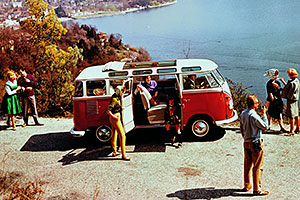
Peene says the bubble is not about to burst. “The more people buy them, the more people see them on the road and want one of their own.” The holy grail of VW campers, a restored 23-window split-screen “Samba”, would now cost £50,000 to £60,000, he says. The Brazilian-built vans are slightly looked down on in the scene, he says, so the end of production there is unlikely to affect prices. Most UK buyers go for German-built Bays from the 1970s, often shipped in from the US.
“You’ve got a lot better than at the start, Daddy,” says my daughter as I grapple with the giant bus-like steering-wheel one last time. What’s more, the van has forced us to take it easier than we might otherwise have done. Scrap that busy itinerary you had planned: you’re never going to do half of it in a vintage camper. As we barrel across Dartmoor, my son up front next to me, peering out at wild scenery and down at drivers in sleek modern motors, an undeniable feeling of being on the open road stirs. If it wasn’t November, I could even see myself reaching for a pair of shorts.
——————————————-
Neil O’Sullivan was a guest of O’Connors Campers (www.oconnorscampers.co.uk). A long-weekend rental (Friday to Monday) costs from £350
——————————————-
When I’m 64: From postwar Germany to retirement in Brazil
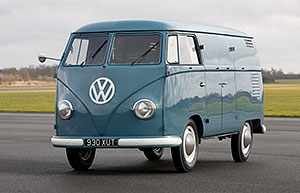
1949 The Volkswagen Type 2 is unveiled at the Geneva Motor Show in November (Type 1 was the Beetle), writes Jocelyn Petrie. The Type 2 had been developed while VW was being run by the British military; control had been returned to the German authorities the previous month.
1950 Production begins at the Wolfsburg factory on March 6. The Type 2, also known as the Transporter, is a basic commercial van, with an aircooled engine at the rear and a split windscreen (hence the nickname “splitty”).
1951 Major Ivan Hirst, a British army officer who played a key role in reviving VW in the postwar years, commissions Westfalia, a coachbuilding company, to convert a Transporter so it can be used for camping. The result, with a cooker, sideboard and folding bench seat, was so successful that the company put it into production.
1953 VW Brazil is founded, quickly becoming the company’s largest foreign subsidiary.
1956 Westfalia sells its 1,000th camper van. Several other companies go on to create camping versions of the Type 2 – VW itself did not make a “camper van” with beds until the California was launched in 1988.
1962 The millionth Type 2 leaves the production line.
1963 Popularity spreads to the US, and Bob Dylan’s second album The Freewheelin’ Bob Dylan features a van on the cover. Later, fans of Grateful Dead start following tours in a camper van convoy.
1967 The “splitty” is superseded by the T2 version, which has a single “bay” windscreen.
1969 According to VW, sales are boosted by the appearance of the “Mystery Machine” van in the cartoon Scooby-Doo.
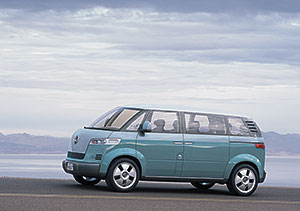
1979 Production stops in Europe as a result of tighter safety regulations, and the classic “smiley-faced” T2 is superseded by the, squarer, more robust T3, nicknamed “the Wedge”. T2 assembly continues in Argentina, Brazil and Mexico.
2001 VW sets fans’ pulses racing by showing a futuristic reimagining of the T2, the Microbus concept car, at the North American motor show, but plans for it are cancelled in 2005.
2011 Early Type 2s are considered valuable classic vehicles. A 1963 Samba version is sold at auction in California for $198,000.
2013 When production ceases in Brazil on December 31, 6.23m of the T1 and T2 will have been built.
Comments